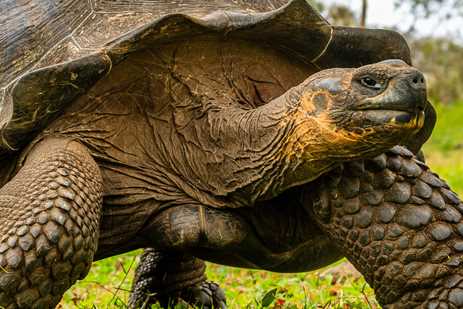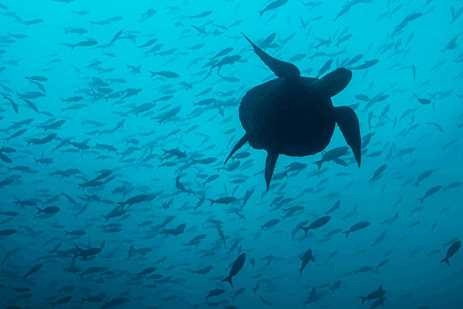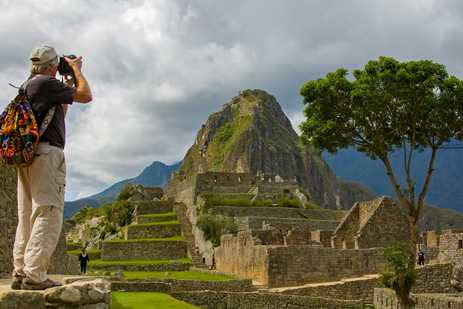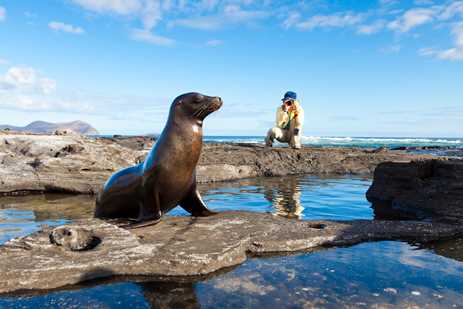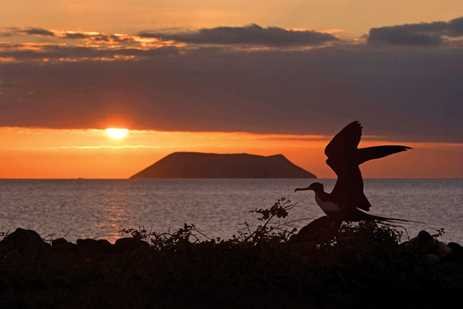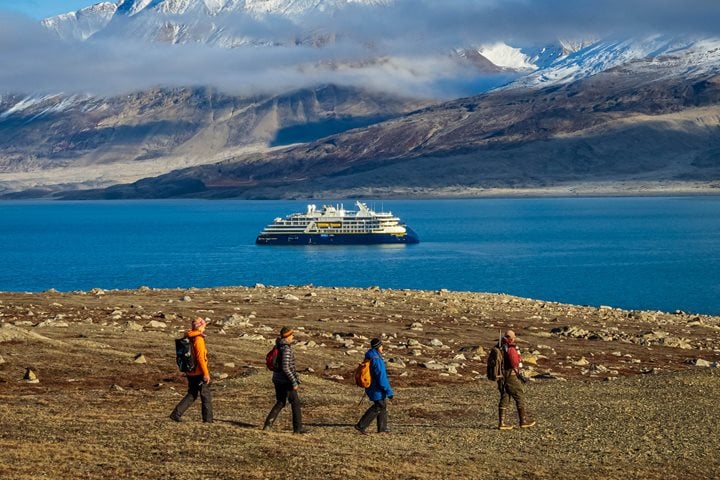Call +1.800.397.3348 or contact your travel advisor
The natural marvels of the Galápagos are truly endless—from its famed wildlife to its otherworldly volcanic landscapes. This spectacular destination is a must-see for nature lovers and curious travelers alike.
Before you get up close and personal with species found nowhere else on Earth, this month-by-month guide will help you learn more about the islands’ weather patterns and equatorial climates so you can prepare for your visit, no matter what time of year you decide to explore.
Complete with travel advice from the experts at Lindblad Expeditions, the company who pioneered expedition travel to Galápagos back in 1967, this comprehensive guide breaks down all you need to know about Galápagos weather, seasons, water temperature, rainfall, and Galápagos Islands wildlife.
The Best Time of Year to Visit the Galápagos
One of the most wonderful things about the Galápagos is that it is magical all year round, says Emma Ridley, Expedition Leader for National Geographic-Lindblad Expeditions. “The main difference is the land and water temperature, so the best time for Galápagos trips is really whatever suits your personal preference,” she says.
The majority of animals are active throughout the whole year so anytime you arrive you can encounter a wide range of incredible species, including sea lions, marine and land iguanas, lava lizards, giant tortoises, green sea turtles, red- and blue-footed boobies, Galápagos penguins, flamingos, Darwin's finches, Galápagos hawks, and much more.
However, Ridley explains that the climate in Galápagos fluctuates between the cool, dry season with productive waters which fuel the marine ecosystems, and the hot, humid season with warm, nutrient-poor waters that lead to rains which fuel the terrestrial ecosystems.
The life cycles of the wildlife are tied to this fluctuation, she says, and that means different months have specific highlights, which you can look at below. Some species breed throughout the year, like magnificent frigatebirds and swallow-tailed gulls. Many other species that have more defined breeding seasons can also be found breeding throughout the year, such as red-footed boobies, Galápagos penguins, and sea lions.
Let’s start with the month of May, which many experts at National Geographic-Lindblad Expeditions agreed is a very enjoyable time of year for Galápagos Islands cruises.
May in the Galápagos Islands
“I think my favorite time to visit the islands is between May and July,” says Naturalist Ramiro Adrian. “The water is warm for snorkeling but cold enough to allow nutrients in the sea to activate the marine ecosystems and their dynamics, like marine bird reproduction, sea lion display, and Pacific sunfish feeding.” That means it’s possible to see an abundance of colorful fish and lively sea lions.
Galápagos Weather in May
- Galápagos high temperature in May: 82 degrees Fahrenheit (28 degrees Celsius)
- Average Galápagos water temperature in May: 74 degrees Fahrenheit (23 degrees Celsius)
- Average Galápagos rainfall in May: 0.6 Inches (1.5 Centimeters)
Best Things to Do on a Galápagos Cruise in May
- Water temperatures are still warm enough to enjoy long snorkeling sessions with abundant sea life like sea lions, sea turtles, and manta rays.
- Since the weather is dry and the air temperatures are cooler, it’s the perfect conditions for long nature walks.
Wildlife You’ll Likely See in the Galápagos During May
- Upwellings of cool, nutrient-rich waters begin creating a higher likelihood of seeing species like manta rays, cetaceans, and Pacific sunfish.
- Albatrosses can be seen courting in large numbers on Española.
- Flightless cormorants and Galápagos penguins start courting and nesting on Fernandina and Isabela.
- Nesting blue-footed boobies have hatchlings and some birds are still courting.
June in the Galápagos Islands
Waved albatross, known for their fascinating mating dances which feature lots of honking and bill clacking, are beginning to lay eggs on Española Island. Blue-footed boobies, also known for their comical mating ritual that includes showing off those vibrant blue feet, are starting their mating season. The water is still warm, and although the air is balmy, there is a breeze that makes the weather very pleasant in June, says Naturalist Gilda Gonzalez.
Galápagos Weather in June
- Galápagos high temperature in June: 78 degrees Fahrenheit (26 degrees Celsius)
- Average Galápagos water temperature in June: 74 degrees Fahrenheit (23 degrees Celsius)
- Average Galápagos rainfall in June: 0.1 Inches (0.254 Centimeters)
Best Things to Do on a Galápagos Cruise in June
- Milder temperatures and school vacations make June an ideal time for families to travel to the Galápagos.
- Since blue-footed boobies are courting and the albatrosses are nesting, this is one of the best months of the year for birdwatching.
Wildlife You’ll Likely See in the Galápagos During June
- Red-footed boobies are at the peak of their nesting season in the trees of Genovesa and San Cristobal.
- Tortoises are migrating to the humid highlands after nesting season to find food and mates.
- Galápagos penguins are found in larger numbers throughout the archipelago and have started to court and reproduce.
- Albatrosses are nesting on Española and the first eggs can be seen.
- Cooler upwellings mean a higher likelihood of seeing species like manta rays, cetaceans, and Pacific sunfish.
July in the Galápagos Islands
“If I had to choose, I would come in July,” says Naturalist José Daniel Guerrero Vela. “The snorkeling is awesome—it is easy to see penguins, marine iguanas, sea turtles, and sea lions while they are enjoying the cold waters and all the available food.” The cooler waters attract many endemic animals to mate.
Galápagos Weather in July
- Galápagos high temperature in July: 76 degrees Fahrenheit (24 degrees Celsius)
- Average Galápagos water temperature in July: 72 degrees Fahrenheit (22 degrees Celsius)
- Average Galápagos rainfall in July: 0.2 Inches (0.6 Centimeters)
Best Things to Do on a Galápagos Cruise in July
- July is another great month for families to visit due to mild weather and convenient school schedules.
- Cool, dry weather conditions and highly active seabird colonies make this a perfect time of year for long nature walks.
- Don a provided wetsuit for snorkeling—waters are cooler, but marine life is abundant and active due to nutrients brought to the surface by upwellings of cold water.
Wildlife You’ll Likely See in the Galápagos During July
- Large numbers of tortoises are grazing in the highlands.
- Humpback breeding season is happening off the coast of mainland Ecuador, creating a higher likelihood of seeing whales in Galápagos.
- Adult albatrosses usually have their first hatchlings.
- The first sea lion pups are arriving and the colonies are bustling with activity.
- Galápagos hawks on the coast gather to feed on the sea lion placenta.
August in the Galápagos Islands
If you want classic Galapagos, with a flurry of animal behaviors, and you prioritize cooler land temperatures over warmer waters, consider exploring in August. “When it’s hot in the northern hemisphere, it’s cool in Galápagos,” says Darrel Schoeling, Director of Expedition Development for Ecuador and Peru. “It’s also peak season for animal behavior because of the cool, nutrient-rich waters bathing the islands.”
Galápagos Weather in August
- Galápagos high temperature in August: 74 degrees Fahrenheit (23 degrees Celsius)
- Average Galápagos water temperature in August: 66 degrees Fahrenheit (19 degrees Celsius)
- Average Galápagos rainfall in August: 0.2 Inches (0.6 Centimeters)
Best Things to Do on a Galápagos Cruise in August
- August is a great time for whale watching from the deck of the ship.
- With cooler temperatures and lots of activity happening in the seabird colonies, head out for long and comfortable nature hikes.
- Marine life is still abundant and active, especially penguins and sea turtles, so add snorkeling (with provided wetsuits!) to the list.
Wildlife You’ll Likely See in the Galápagos During August
- Large numbers of Galápagos tortoises are grazing in the lush highlands.
- Abundant algal beds make it easier to find marine iguanas grazing in the shallows.
- Galápagos penguins are actively hunting for food for their young.
- A number of seabird hatchlings, including blue and red-footed boobies, albatrosses and frigatebirds, are growing and becoming fledglings.
- Growing sea lion pups are more active on land and in the water.
- Higher likelihood of seeing humpback whale mothers and calves in the archipelago.
September in the Galápagos Islands
This is when many types of whales, dolphins, mantas, mobula rays and even whale sharks visit these protected waters. “It’s when the water is colder and you have wonderful snorkeling,” says Hotel Director Juan Sebastian Guijarro Ruiz. “Three out of the five blue whales I’ve seen were spotted in September.”
Galápagos Weather in September
- Galápagos high temperature in September: 76 degrees Fahrenheit (24 degrees Celsius)
- Average Galápagos water temperature in September: 68 degrees Fahrenheit (20 degrees Celsius)
- Average Galápagos rainfall in September: 0.3 Inches (0.8 Centimeters)
Best Things to Do on a Galápagos Cruise in September
- Larger marine life is often spotted, making it a thrilling time for Zodiac rides, kayaking, and whale-watching.
- Enjoy long hikes among active sea lion and seabird colonies.
Wildlife You’ll Likely See in the Galápagos During September
- Albatross hatchlings are growing; many adults are returning to court and find mates for the first time.
- Large numbers of Galápagos tortoises are still grazing up in the highlands.
- Marine iguanas are still grazing in the shallows on the abundant algal beds.
- Galápagos penguins continue to hunt in order to feed their young.
- Growing sea lion pups continue to be more active on land and in the water.
- Higher likelihood remains to see humpback mothers and calves in the archipelago.
- Flightless cormorant chicks are growing on Fernandina and Isabela.
October in the Galápagos Islands
There are fewer courtship displays in October, but this can still be an exciting month to visit the Galápagos Islands. Many baby animals—from sea lion pups to albatross chicks—are finding their footing and learning how to navigate the harsh environments. Plus, prehistoric-looking marine iguanas and adorable fur seals begin their breeding season.
Galápagos Weather in October
- Galápagos high temperature in October: 77 degrees Fahrenheit (25 degrees Celsius)
- Average Galápagos water temperature in October: 70 degrees Fahrenheit (21 degrees Celsius)
- Average Galápagos rainfall in October: 0.3 Inches (0.8 Centimeters)
Best Things to Do on a Galápagos Cruise in October
- Wildlife spotting is fun for the whole family during October, when many baby animals are out in abundance.
- The balmy October temperatures make it an inviting time for both land activities as well as stand-up paddleboarding, kayaking, and snorkeling.
Wildlife You’ll Likely See in the Galápagos During October
- It’s breeding time for the salt-sneezing marine iguanas on Fernandina; you’ll also start seeing the colorful male “Christmas iguanas” on Española.
- Albatross chicks are still hatching, creating vocal shows and opportunities to observe the species’ parental instincts.
- Fur seals, green sea turtles, and land iguanas are still active as they begin their mating seasons.
- Juvenile Galápagos penguins can be found (and heard braying loudly!) on the shoreline.
- It’s still a great time to see an abundance of giant tortoises up in the highlands.
- Sea lion pups are getting bigger and more active—it’s a great time for snorkeling with sea lions!
November in the Galápagos Islands
Galápagos Weather in November
- Galápagos high temperature in November: 78 degrees Fahrenheit (26 degrees Celsius)
- Average Galápagos water temperature in November: 72 degrees Fahrenheit (22 degrees Celsius)
- Average Galápagos rainfall in November: 0.2 Inches (0.6 Centimeters)
Best Things to Do on a Galápagos Cruise in November
- With still cool and mostly dry conditions, enjoy hikes or leisurely photos walks ashore.
- Sea water temperatures are beginning to rise, making snorkeling in the productive waters delightful.
Wildlife You’ll Likely See in the Galápagos During November
- Green sea turtle mating season continues and they start to congregate off the beaches.
- Juvenile Galápagos penguins can be found (and heard braying loudly!) on the shoreline.
- There are still large numbers of giant tortoises grazing in the highlands.
- Sea lion pups are getting bigger and more active—it’s a great time for snorkeling with sea lions!
- Mating season for both land and marine iguanas—lots of territorial fighting throughout the islands.
- Fledgling albatross chicks spend a lot of time alone waiting for their parents to return.
December in the Galápagos Islands
Like May, December is one of the best months of the year weather-wise—the water is warmer, but it’s not too hot or humid on land yet. As the rain begins, travelers will start to see the first flowers and leaves reappear. Plant life like the Floreana daisy and the Galápagos lantana is in bloom and animal chicks are older and more playful, says Naturalist Paula Tagle.
Galápagos Weather in December
- Galápagos high temperature in December: 80 degrees Fahrenheit (27 degrees Celsius)
- Average Galápagos water temperature in December: 74 degrees Fahrenheit (23 degrees Celsius)
- Average Galápagos rainfall in December: 0.3 Inches (0.8 Centimeters)
Best Things to Do on a Galápagos Cruise in December
- Celebrate the holiday season with family or friends among the incredible wildlife.
- The waters are warming, providing clearer snorkeling conditions, ideal for seeing active sea lion pups, colorful reef fish and grazing sea turtles.
Wildlife You’ll Likely See in the Galápagos During December
- Mating season continues for sea turtles as well as land and marine iguanas.
- Female marine iguanas start digging nests in sandy areas.
- View sea turtle nesting tracks on the beaches and some hatching might be seen.
- An array of land birds including Darwin’s finches, mockingbirds, flycatchers, warblers, and hawks start to nest.
- Giant tortoises are still seen in the highlands but in smaller numbers as they migrate down to the lowlands to mate and nest.
- Sea lion pups are getting larger and very playful around snorkelers.
January in the Galápagos Islands
If you would like your Galápagos cruise to feel like a tropical getaway, January is the month that brings summer to the equatorial islands. Though it's hot and humid at this time, it is bearable since you can cool off by swimming or snorkeling nearly every day from beautiful beaches.
Galápagos Weather in January
- Galápagos high temperature in January: 84 degrees Fahrenheit (29 degrees Celsius)
- Average Galápagos water temperature in January: 74 degrees Fahrenheit (23 degrees Celsius)
- Average Galápagos rainfall in January: 2 Inches (5 Centimeters)
Best Things to Do on a Galápagos Cruise in January
- Snorkeling is possible without a wetsuit in warm, clear waters.
- The islands are lush and green, providing a verdant environment for terrestrial animals and making beach walks and hikes especially appealing
Wildlife You’ll Likely See in the Galápagos During January
- Marine iguanas are courting on Española Island where some of the males turn bright green and red for the occasion; females are digging nests in sandy areas.
- Red-footed booby juveniles, in their first plumage, are curious and playful.
- Land birds, like Darwin’s finches, mockingbirds, flycatchers, hawks, and warblers, continue to nest and be more active than other months of the year.
- It’s near the peak of nesting season for green sea turtles with lots of tracks and nests seen on the beaches as well as hatching spotted.
- It’s breeding season for land iguanas and tiny lava lizards.
- Giant tortoises continue to migrate down from the highlands to the lowlands.
February in the Galápagos Islands
In February, the Galápagos Islands are warming up to feel quite hot, which can be a benefit for travelers who are looking for more time snorkeling or scuba diving. (Note: National Geographic-Lindblad Expeditions offers diving on select departures aboard National Geographic Endeavour II for experienced divers at an additional cost.) The drought-deciduous Palo Santo trees that cover the islands have all burst into leaf and there’s still plenty of activity happening on land, from nesting flamingos to the start of the Santa Cruz marine iguana breeding season.
Galápagos Weather in February
- Galápagos high temperature in February: 86 degrees Fahrenheit (30 degrees Celsius)
- Average Galápagos water temperature in February: 76 degrees Fahrenheit (24 degrees Celsius)
- Average Galápagos rainfall in February: 2.6 Inches (6.6 Centimeters)
Best Things to Do on a Galápagos Cruise in February
- Snorkeling and scuba diving are ideal as waters are warm and clear, and it’s a refreshing break from the sun.
- Hikes are enjoyable as the islands are lush and green, attracting pollinating butterflies.
Wildlife You’ll Likely See in the Galápagos During February
- Santa Cruz marine iguanas are breeding and nesting.
- Land birds, like flamingos, Galápagos doves, Darwin’s finches, and mockingbirds, are all nesting and very active.
- Peak nesting season for green sea turtles means lots of tracks and nests seen on the beaches as well as hatching spotted.
- Terrestrial invertebrates like butterflies and Galápagos carpenter bees are busy pollinating the flowering endemic plants.
- Great frigatebirds and red-footed boobies begin to court again.
- The warm, clear waters are teeming with tropical reef fish, sea lions, turtles, penguins and white-tipped reef sharks. Manta rays start to return.
March in the Galápagos Islands
Naturalist Tom Ritchie says that his personal favorite time is the period around the end of the rainy season, which most years is March, “Because things are greenest and pleasant inland and the blue-footed boobies are doing their mating dance displays.”
Galápagos Weather in March
- Galápagos high temperature in March: 88 degrees Fahrenheit (31 degrees Celsius)
- Average Galápagos water temperature in March: 76 degrees Fahrenheit (24 degrees Celsius)
- Average Galápagos rainfall in March: 3.3 Inches (8.4 Centimeters)
Best Things to Do on a Galápagos Cruise in March
- See the comical mating rituals of the blue-footed boobies, and other seabirds.
- It’s still a hot time of year, which makes for good snorkeling and scuba diving excursions for experienced divers
Wildlife You’ll Likely See in the Galápagos During March
- Blue-footed boobies are showing off their colorful feet to potential mates.
- Red-footed boobies as well as great and magnificent frigatebirds begin courting season around this time.
- Marine iguana hatchlings start to appear.
- Manta rays are seen throughout the archipelago.
- Giant tortoises are still seen in the highlands but you’ll have to search a bit since many have migrated down to the lowlands.
April in the Galápagos Islands
“I particularly love April in the Galápagos,” says Naturalist Alexandra Widman. “The water is still warm and the world’s population of waved albatrosses begin to return to Española Island to reunite with their lifelong partners and show off their legendary dance moves.”
Galápagos Weather in April
- Galápagos high temperature in April: 86 degrees Fahrenheit (30 degrees Celsius)
- Average Galápagos water temperature in April: 76 degrees Fahrenheit (24 degrees Celsius)
- Average Galápagos rainfall in April: 1.4 Inches (3.6 Centimeters)
Best Things to Do on a Galápagos Cruise in April
- Birdwatching is very popular as the waved albatrosses are returning to the islands and displaying their famed mating rituals.
- Snorkeling among green sea turtles is very likely.
Wildlife You’ll Likely See in the Galápagos During April
- Waved albatrosses are back from sea in large numbers to begin mating season.
- Blue- and red-footed boobies and frigatebirds continue displaying mating rituals.
- Juvenile land and marine iguanas can be seen this time of year.
- Green sea turtle hatching begins, and the waters are more active with adults as well.
- An array of land birds, from warblers to hawks, are still nesting and very active.
- Manta rays are seen throughout the archipelago.
Learn more about traveling to the Galápagos
Learn more about the best Galápagos islands to visit.
Best Seasons to Visit the Galápagos Islands
The best time of year to take a Galápagos cruise is heavily dependent on what you wish to see and tour on the islands. As you’ll see below, there are three main Galápagos seasons.
Galápagos Warm Season (Galápagos Rainy Season)
Galápagos in summer, which is January to April, brings the hottest and most humid weather, creating a tropical environment. The waters are warm and clear, making the warm season ideal for snorkeling and scuba diving, and the lush islands are teeming with active land animals.
Galápagos Cool Season (Galápagos Dry or “Garua” Season)
June to November is considered the cool season in the Galápagos Islands. Many consider these months to be some of the best for wildlife viewing, as most of the animals are mating and producing offspring, which creates exciting activity.
The waters are also colder and therefore nutrient rich, which attracts a larger variety of sea life — although the visibility is less than in the warm season when the water is clearer.
Galápagos Transition Seasons
May, December, and September are considered off (or shoulder) seasons in the Galápagos Islands. Some think these three transition months can be the best times to visit the islands, as the weather is mild and you can benefit from some of the perks of both major seasons.
Daylight Hours in Galápagos
Due to the archipelago’s equatorial location, the sun varies by two degrees year round, which provides an average of 12 hours of sunlight each day. Sunsets here can be exceptionally dramatic and beautiful, providing some incredible photo ops.
Galápagos Islands Water Temperature
Just like the air temperature, the water only varies by about 10 degrees throughout the year. The warmer waters tend to be clearer. Colder temperatures have less visibility due to the abundance of nutrients that come from upwellings.
Regardless of the time you choose to explore, you will be able to snorkel in comfort if you gear up properly with a protective wetsuit. If you travel with National Geographic-Lindblad Expeditions, wetsuits are provided for every guest aboard to use for the duration of their voyage, making it seamless and easy.
| January | February | March | April | May | June | July | August | September | October | November | December | |
| Average rainfall (inches) | 2.0 | 2.6 | 3.3 | 1.4 | 0.6 | 0.1 | 0.2 | 0.2 | 0.3 | 0.3 | 0.2 | 0.3 |
| Average high temperature (fahrenheit) | 84 | 86 | 88 | 86 | 82 | 78 | 76 | 74 | 76 | 77 | 78 | 80 |
| Average low temperature (fahrenheit) | 70 | 74 | 77 | 72 | 72 | 68 | 66 | 64 | 62 | 64 | 66 | 68 |
When Is the Best Time to Go Snorkeling in Galápagos?
Sea life is most active when the water temperature is cooler from June to November. This is due to the fact that deeper, more nutrient-dense water can more easily rise to the sunlit surface areas, attracting wildlife.
If snorkeling Galápagos in less brisk conditions is what you’re hoping for, opt for December to May, when the visibility is better and you can spend more time in the water looking for fascinating Galápagos marine life.
Worst Time to Visit Galápagos
When it comes down to it, there is never a bad time to visit the Galápagos because there is always so much happening every time of year. As Ridley sums it up:
“Choose a time of the year according primarily to your climatic preferences. If spending a lot of time in the water is an important motivator, then the hot season might be best. If hot, tropical conditions on land are not well tolerated, then the cooler season will be a lot more pleasant. It is important to note though that the boundaries between the seasons are blurring more and more, like in most parts of the world, and there seems to be longer hot seasons, so there are no real guarantees.”
Bottom line: With the archipelago’s unique equatorial location, year-round breeding and migratory patterns, and mild temperature changes, a Galápagos cruise will offer an exciting adventure whenever you choose to explore.



